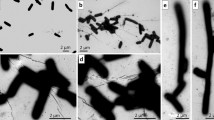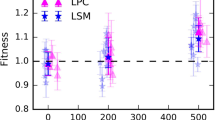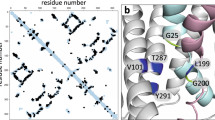Abstract
SPORES of the cellular slime mould Dictyostelium discoideum will germinate in liquid culture at relatively high densities (<5 × 106 spores/ml.), especially if they are provided with bacteria on which the amoeboid cells can feed1. When the spore density becomes very high (>2 × 107 spores/ml.), however, germination will not take place at all. The cause is thought to be an inhibitor secreted by the spores themselves2.
This is a preview of subscription content, access via your institution
Access options
Subscribe to this journal
Receive 51 print issues and online access
$199.00 per year
only $3.90 per issue
Buy this article
- Purchase on Springer Link
- Instant access to full article PDF
Prices may be subject to local taxes which are calculated during checkout
Similar content being viewed by others
References
Cotter, D. A., and Raper, K. B., Proc. US Nat. Acad. Sci., 56, 880 1966).
Cotter, D. A., and Raper, K. B., J. Bact., 96, 1680 (1968).
Dearing, R. A., J. Bact. (in the press).
Hashimoto, Y., and Yanagisawa, K., Radiat. Res. (in the press).
Raper, K. B., J. Agric. Res., 58, 157 (1939).
Bonner, J. T., The Cellular Slime Molds, second ed. (Princeton University, Princeton, 1967).
Sussman, M., Method. Cell Physiol., 11, 397 (1966).
Author information
Authors and Affiliations
Rights and permissions
About this article
Cite this article
HASHIMOTO, Y. Effect of Radiation on the Germination of Spores of Dictyostelium discoideum. Nature 231, 316–317 (1971). https://doi.org/10.1038/231316a0
Received:
Issue Date:
DOI: https://doi.org/10.1038/231316a0
This article is cited by
-
Effects of UV-light andγ-rays on the survival, akinete formation and akinete germination inStigeoclonium pascheri
Folia Microbiologica (1987)
-
The effect of gamma radiation on breaking of dormancy in Phycomyces spores
Archives of Microbiology (1977)
-
Spore germination in Dictyostelium discoideum
Archives of Microbiology (1976)
-
Germination and mitochondrial damage in spores of Dictyostelium discoideum following supraoptimal heating
Archives of Microbiology (1975)
Comments
By submitting a comment you agree to abide by our Terms and Community Guidelines. If you find something abusive or that does not comply with our terms or guidelines please flag it as inappropriate.



